
George Cruikshank, “Eva Dressing Uncle Tom,” wood engraving, from Harriet Beecher Stowe, Uncle Tom’s Cabin, London, 1852. (Courtesy, Harriet Beecher Stowe Center.) Staffordshire manufacturers often replicated the relative scale and pose of Eva and Tom in their figural reproductions based on characters in Stowe’s novel.

Hammatt Billings, “Eliza on the Ice Floes,” wood engraving, from Harriet Beecher Stowe, Uncle Tom’s Cabin, the Illustrated Edition, Boston, 1853. (Courtesy, Harriet Beecher Stowe Center.) Billings’s rendering of Eliza as a Caucasian helped to elicit sympathy for the character’s plight. In Staffordshire, Eliza is also shown as white, whereas French ceramic manufactories tend to show her skin color more accurately.

“Tom et Evangeline” and “La Fuite d’Elise,” Limoges, ca. 1852–1853. Biscuit- and glazed hard-paste porcelain with polychrome enamels and gilding. H. 11 3/4". (Courtesy, Harriet Beecher Stowe Center; photo, author.)

Charles Bour, “Tom et Evangeline,” lithograph, from Harriet Beecher Stowe, La Case de l’Oncle Tom, Paris, 1853. (Courtesy, Harriet Beecher Stowe Center, 68.288.Pr.F3.)

Bettannier, “La Fuite d’Elise,” lithograph, from Harriet Beecher Stowe, La Case de l’Oncle Tom, Paris, 1853. (Courtesy, Harriet Beecher Stowe Center, 68.288.Pr.F3.)

Anonymous, “Eva and Uncle Tom,” from Harriet Beecher Stowe, Pictures and Stories fromUncle Tom’s Cabin, Boston, 1853. (Courtesy, Harriet Beecher Stowe Center.) This was a juvenile edition of Stowe’s novel. Note the shape of Tom’s eyes and his unusually expressive face. The style of illustration is orientalist and idealized, rather than relying on caricature and overexaggerated features. This approach to depicting negroid features typifies the French decorative style, whether on vases or tablewares.
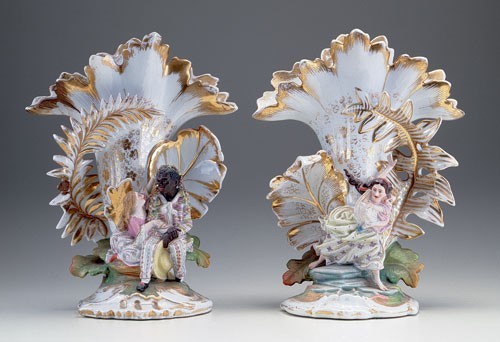
“Tom et Evangeline” and “La Fuite d’Elise,” Limoges, ca. 1850–1860. Biscuit- and glazed hard-paste porcelain with polychrome enamels and gilding. H. 11 3/4". (Courtesy, Museum of Fine Arts, Houston; Bayou Bend Collection, museum purchase in memory of Genevieve Lydian Dutton Gundry by her son Jas A. Gundry, acc. nos. b2000.6.1, 6.2.) Although these figures share similar pastel palettes, the gilding on each of the pairs diVers dramatically.
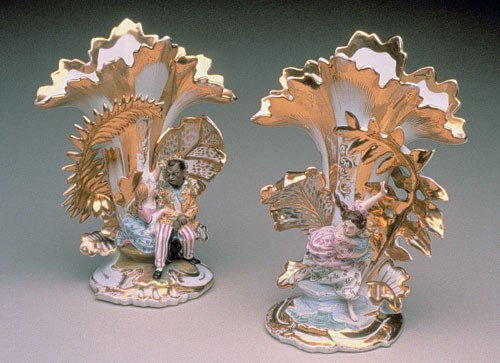
“Tom et Evangeline” and “La Fuite d’Elise,” Limoges, ca. 1852–1853. Biscuit- and glazed hard-paste porcelain with polychrome enamels and gilding. H. 11 3/4". (Courtesy, Rex Stark; photo, Gavin Ashworth.) These and several other pairs of vases are decorated with fanciful enameling, but no two pairs have surfaced with identically painted features.
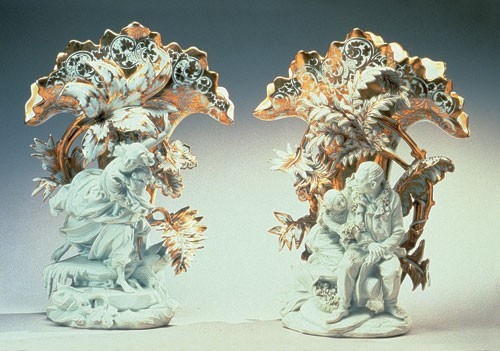
“Tom et Evangeline” and “La Fuite d’Elise,” Limoges, ca. 1852–1853. Biscuit- and glazed hard-paste porcelain and gilding. H. 19". (The Newark Museum, Newark, New Jersey, Purchase 1968, Mrs. Parker O. Griffith Fund, 68.106 a,b.)

Nathaniel Orr and Company, “Saleroom, Main Floor, Haughwout Building, New York,” wood engraving, from Cosmopolitan Art Journal 3 (June 1859). (Courtesy, the author.) This view of the ground-floor premises of the retailing emporium of Haughwout and Dailey at 540 Broadway shows a tantalizing survey of stylish porcelain and glass available for purchase in the 1850s. Haughwout’s hired women—mostly from Staffordshire but also from porcelain towns in eastern France and western Germany—to work as decorators in the custom workshop upstairs from the main selling floor. Many of the Uncle Tom’s Cabin-motif French vases might have acquired their unusual coloration and gilding styles from the women decorators working at this establishment.

Figurines based on characters from Uncle Tom’s Cabin, Staffordshire potteries, Stoke-on-Trent, ca. 1852–1860. Bone china. H. of tallest approx. 8". (Courtesy, Rex Stark; photo, Rex Stark.)
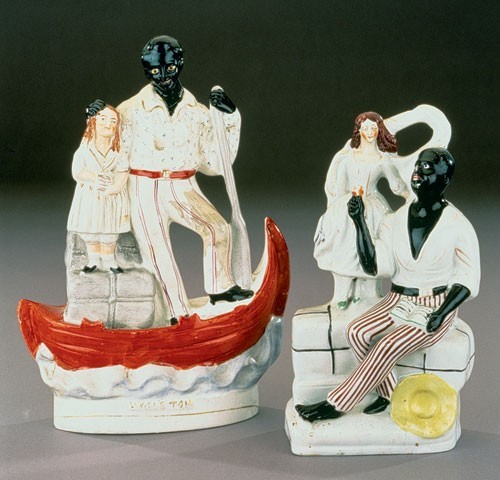
Left: “Eva, Uncle Tom, Boat,” Dudson factory, Stoke-on-Trent, ca. 1852–1855. Whiteware. Right: “Eva and Uncle Tom on the Boat,” unknown factory, Stoke-on-Trent, ca. 1852–1855. Whiteware. H. of tallest 7". (Courtesy, Christie’s, London.) “Eva, Uncle Tom, Boat” is the only figural group whose attribution to a specific Staffordshire factory producing earthenware figures based on Uncle Tom’s Cabin is confirmed.

Figural group, “Eva, Uncle Tom, Boat,” Dudson factory, Stoke-on-Trent, ca. 1852–1855. Whiteware. H. 7". (Courtesy, Harriet Beecher Stowe Center, 81.18.)
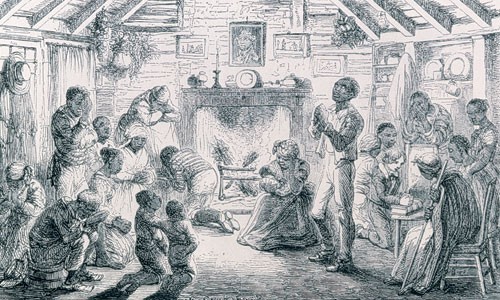
George Cruikshank, “Prayer Meeting inUncle Tom’s Cabin,” from Harriet Beecher Stowe, Uncle Tom’s Cabin, London, 1852.

Plate, “PRAYER MEETING,” unknown factory, Stoke-on-Trent, ca. 1852–1855. Molded earthenware transfer-printed in warm black enamel. D. 7 5/8". (Courtesy, Harriet Beecher Stowe Center, 81.34.) The image of the “Prayer Meeting” is taken directly from the Cruikshank illustration shown in fig. 14. The mantel decor is typical of aspirational middle-class taste, not a true slave home interior

Plate, “UNCLE TOM'S CABIN / ELIZA CROSSING THE OHIO ON THE FLOATING ICE,” unknown factory, Stoke-on-Trent, ca. 1855. Earthenware with molded rim, transfer-printed in warm black enamel. D. approx. 5". (Courtesy, Harriet Beecher Stowe Center, 81.28.) This plate shows a revised illustration for Uncle Tom’s Cabin. Note that Eliza and Baby Harry are running toward the right side of the plate, whereas the standard orientation shows them running toward the left. The plate imagery is highly degraded.

Two-handled cups, probably Staffordshire, ca. 1854-1858. Whiteware. H. of tallest 6". Courtesy, Rex Stark; photo, Gavin Ashworth.) Compared to plates, these unusual hollow-bodied wares were relatively expensive to produce. On the smaller cup is depicted Topsy, who, while supposedly working at Olivia's house, is being mischievous. "MASTER GEORGE TEACHING TOM" appeard on the trophy cup. Both images are from Cruikshank's illustrations for the first English edition of Stowe's novel.
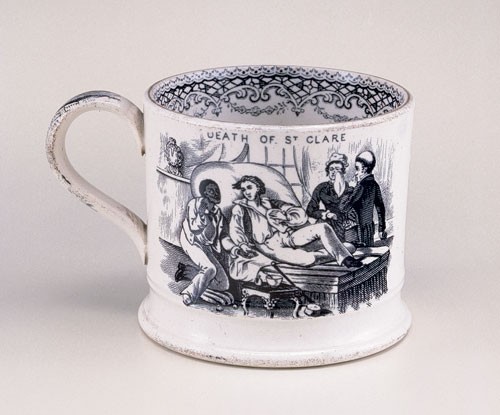
Mug, probably Staffordshire, ca. 1852–1855. Whiteware. H. 2 1/2". (Courtesy, Rex Stark; photo, Gavin Ashworth.) Some of the Uncle Tom prints used by ceramic factories provide wonderfully detailed views of mid-nineteenth-century Victorian interiors. George Cruikshank’s “DEATH OF ST. CLARE” has been transposed from the English edition of Stowe’s novel to this child’s cup. The louche plantation owner is surrounded by fine furniture and other talismans of wealth.
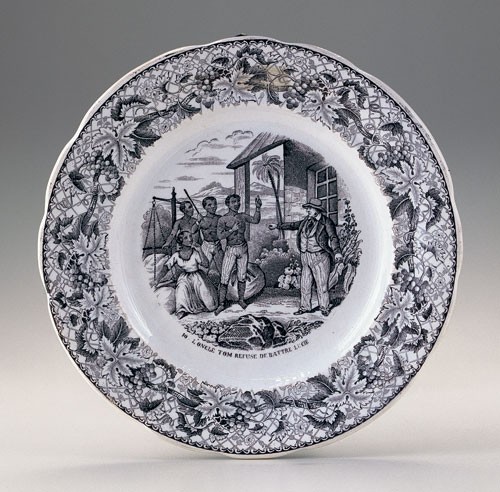
Plate, attributed to J. Vieillard et Cie., Bordeaux, ca. 1855. Whiteware. D. 8". (Courtesy, Rex Stark; photo, Gavin Ashworth.) This plate illustrates the scene “Uncle Tom Refuses to Hit Legree” (L’Oncle Tom Refuse de Battre Legree). The international success of Stowe’s novel was fueled by worker literacy movements on the Continent. Because Stowe capitalized on the popularity of the sentimental novel, women bought her book; men bought it for the action within; and religious groups and parents approved of its high moral tone. The novel was printed in more languages and in more countries at mid-century than any book other than the Bible.
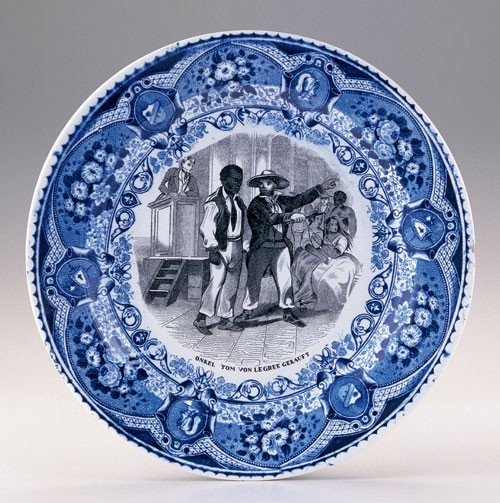
Plate, Schramburg, Germany, ca. 1855. Whiteware. D. 8". (Courtesy, Rex Stark; photo, Gavin Ashworth.) This two-color transfer-printed plate illustrates “Uncle Tom Leaving with Legree” (Onkel Tom mit Le Gree Gereitt).
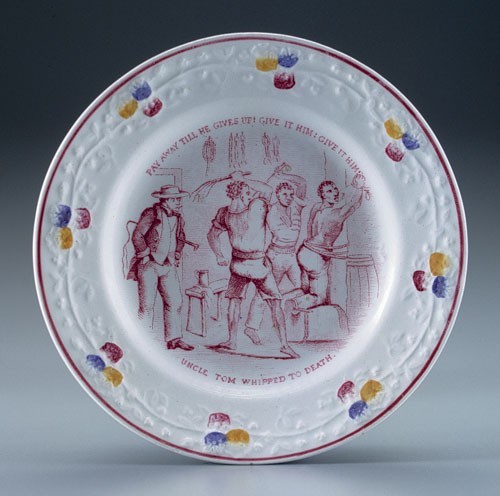
Plate, probably Staffordshire, ca. 1855. Earthenware. D. 6 1/4". (Courtesy, Rex Stark; photo, Gavin Ashworth.) This molded polychrome-painted and transfer-printed plate depicts “THE DEATH OF UNCLE TOM,” based on Cruikshank’s illustration.
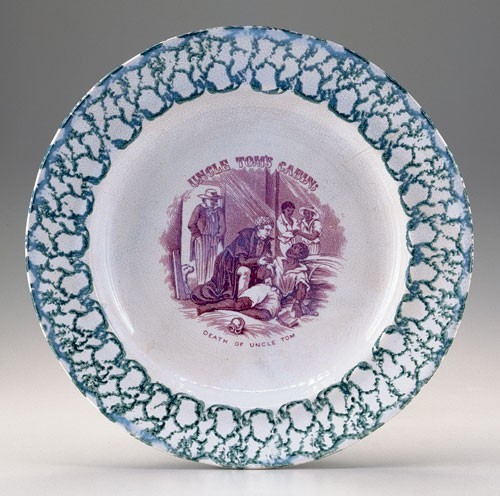
Plate, probably northern England or Scotland, ca. 1855. Whiteware. D. 7". (Courtesy, Rex Stark; photo, Gavin Ashworth.) This earthenware polychrome transfer-printed and painted plate illustrates the “DEATH OF UNCLE TOM.” The plate was meant to appeal to a person of higher social standing than the example shown in fig. 21. Here, the teal blue sponged border frames the puce image of Tom lying on his deathbed.

Plate, J. Vieillard et Cie., Bordeaux, ca. 1855. Whiteware. D. 8". (Courtesy, Rex Stark; photo, Gavin Ashworth.) This plate has an even more delicate rendering of the tragic death of Uncle Tom. The elaborate printed blue border is quite wide, diminishing the visual impact of the central image. Uncle Tom’s death, illustrated in a warm, charcoal black with delicate detail, is based on an entirely different print source from the previous images, Girard’s steel-cut engravings for the first French edition of Uncle Tom’s Cabin (1853).
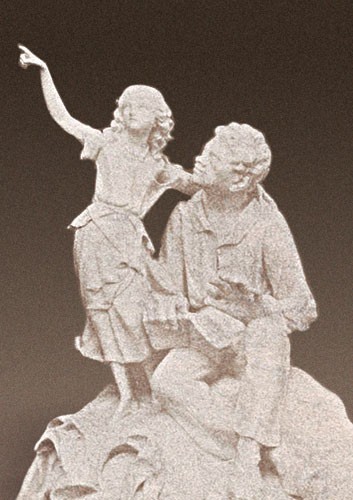
“Eva and Uncle Tom,” parian sculpture from the Royal Worcester production catalogue, ca. 1853–1855. Salt print photograph. 3 1/8" x 2". (Courtesy, The Worcester Porcelain Museum.) Wendy Cook, curator at the museum, has seen only one example of this figural group, and it was painted with polychrome enamels.

Southworth and Hawes, Harriet Beecher Stowe. Quarter-plate daguerreotype, ca. 1850. 4 1/4" x 3 1/4". (Metropolitan Museum of Art, New York, Gift of I.N.Phelps Stokes, Edward S. Hawes, Alice Mary Hawes, and Marion Augusta Hawes, 1937, acc. no. 37.14.40.)

Mug, Staffordshire, ca. 1855–1860. Earthenware. H. approx. 8". (Courtesy, Rex Stark; photo, Gavin Ashworth.) Transfer-printed in warm medium blue, the legend reads “Mrs. Harriet Beecher Stowe / AUTHOR OD UNCLE TOM'S CABIN.”
